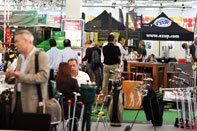 Length is one of the primary developments affecting the design of new clubs for 2011. More often than not it is the details and improvements which confirm that a prior development was the right step. The hardware innovations for 2011, presented at Golf Europe at the M,O,C, from September 26 – 28, are the proof.
Length is one of the primary developments affecting the design of new clubs for 2011. More often than not it is the details and improvements which confirm that a prior development was the right step. The hardware innovations for 2011, presented at Golf Europe at the M,O,C, from September 26 – 28, are the proof.
- Multi-axis adjustments for drivers
- Multi-material clubs simplify accurate ball contact
- Beautiful black
- Smooth transitions
- Putter with targeting aids
Multi-axis adjustments for drivers
Adjustable drivers – gimmick or trend; this was the question two years ago when the first adjustable tee-off woods created a stir. The question has not completely been answered yet, though it is evident that the next level has been reached in the development of adjustable drivers. Clubs are now adjustable on not just one but multiple axes: in the past, the adjustment consisted mainly of moving the club head to the left or the right, and opening or closing of the club face. New features include fine- tuning of the club head’s loft as well of the lie. Manufacturers offer a number of solutions with the help of specialized threads. New features include options for lengthening the shaft with the help of a shaft insert (Adams). Another system is designed to keep the position the same even though the club is adjusted. With the help of a specially designed inner tube loft, lie, and club head position can be changed to purposely initiate a draw or fade, but the player does not actually feel any changes in the club itself. (Honma).
 Spin control is an issue usually related to wedges (high level of back spin to quickly stop the ball). This issue has now gained the attention of driver designers, though from the opposite end of the spectrum. With the help of hi-tech software programs manufacturers design club heads generating as little spin as possible resulting in more accurate trajectories and increased coasting distances.
Spin control is an issue usually related to wedges (high level of back spin to quickly stop the ball). This issue has now gained the attention of driver designers, though from the opposite end of the spectrum. With the help of hi-tech software programs manufacturers design club heads generating as little spin as possible resulting in more accurate trajectories and increased coasting distances.
These days, there are more standard driver shafts available than ever. This is a result of the custom fitting trend, and the desire to increase the ability to satisfy individual swing profiles. In 2011, alignment aids, commonly found in putter heads, will also be available in elegant designs integrated into tee-off club heads (Bridgestone).
Multi-material clubs simplify accurate ball contact
In the iron segment the year 2011 promises clubs that are even more forgiving yet by no means awkward-looking. The purposeful use of a variety of synthetic materials combined with steel and steel alloys made club designs possible that approach new limits and open up game-assisting club construction options – sporty, modern, and elegant. Paper-thin contact areas on the club face (e.g. Mizuno, Callaway) elastomer reinforcements, lattice-style and elaborately designed multi-material club head back sides dominate the look (TaylorMade). The degree of synthetic materials used in different areas of the club heads continues to increase. This causes a higher degree of weight distribution to the edges of the club face and the sole while keeping the weight of the head the same or even decreasing it. On the course, this translates into easier ball contact with less effort – clubs provide longer trajectories even for swings with not so perfect ball contact.
The rich sound of a good swing and ball contact is perceived as a positive feeling. Thus modern club head design also focuses on vibration absorption. The most important material for this task is elastomer. The back side of the club head can be lined with a special type of elastomer, featuring a high degree of shock absorption characteristics even if only a very thin layer is used. This material is also used for shock absorption in bridge construction (Wilson). Some companies even integrated elastomers into their shafts (Bridgestone). Other areas of use include the top edge and the sole of club heads.
Smooth Transitions
Combination and transition sets, in which the lower irons (4 and 5) and sometimes even the medium irons (6 und 7) are substituted by hybrid clubs, are gaining more market share in the segment of “play-assisting clubs”. The advantage of these club sets is a smooth transition from irons to woods.
The transition is not just visual but also in the consistent increase in length from head to head. Many golfers generate only flat trajectories with their long irons, which let the ball coast for some distance, but the ball generally does not stay suspended in air long enough to clear obstacles. Thanks to their design, hybrid clubs (the centre of gravity is moved towards the rear of the club head) help generate a higher ball launch and effectively a longer flight trajectory. The advantage of club sets with integrated hybrid clubs in contrast to hybrid clubs purchased in addition to a standard set, is that all clubs coordinate with each other in terms of shaft length, grip, weight, loft, and lie.
Beautiful black
Beautiful black is the trend-setting surface color for 2011. Companies use a number of coating technologies, in particular PVD, for a dark finish for putters, irons and hybrid clubs (TaylorMade, Honma, Adams etc.).
Putters with targeting aids
Putters have developed their own sales dynamics on the golf market, comparable of that of drivers.
High-end, milled models made of stainless steel or aerospace aluminum are clearly in trend. In terms of shaping, modern high-MOI putters have gained a place next to classic blades and mallets; the new models for 2011 cover the entire range. Putters can reach moments of inertia values of up to 6000 and even more (e.g. Rife). Advantage: a high MOI practically results in an automatic “anti-twist” effect – meaning the player has less of a change to inadvertently twist the putter head. Alignment aids are also an important topic: proven alignment aids such as standard sighting marks are now available in extended versions (SeeMore); Mizuno presents the company’s own new targeting aid: Line 90. The spotlight is also on new putter grips, in particular combined with custom fitting, since material and grip width have an impact on the feeling of the putt. The discussion continues on putters with exchangeable weights. Last but not least, finishes in rainbow colours, as seen years ago, are celebrating a revival in 2011 (Rife).
GOLF EUROPE www.golf-europe.com/en/home

